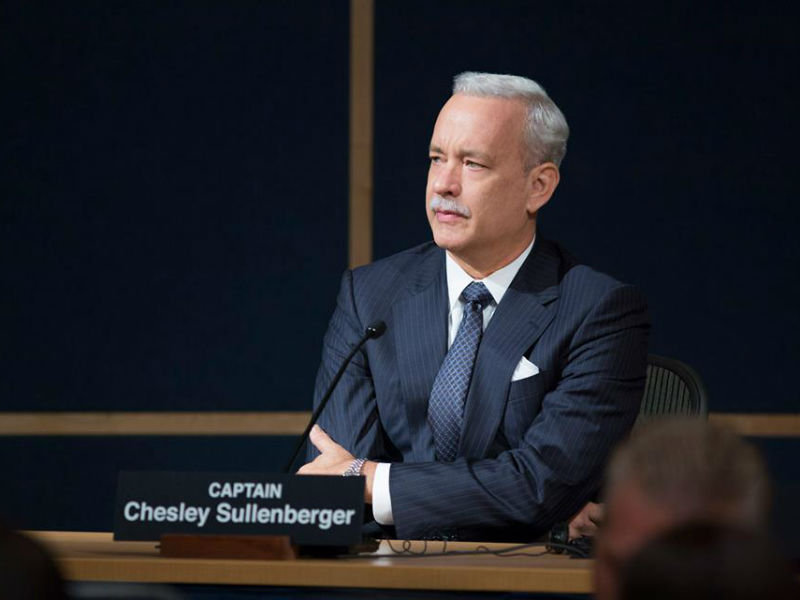208 seconds. That’s all the time Captain Chesley Sullenberger had to assess his dire situation, make an informed yet literally on-the-fly life-or-death decision, do everything right and turn a seeming disaster instead into a moment of incredible, true heroism – in addition to a deep nationwide sigh of relief.
It’s no wonder Hollywood would want to adapt such a triumph into a movie: a terrifyingly relatable, high-flying, ripped from the headlines horror relieved by an affable, everyman savior – several everyman saviors, actually, as the film nobly attempts to point out. But as great of a story it is … it’s still just 208 seconds.
And while director Clint Eastwood works those barely three and a half minutes to the best of his limited late-career capabilities, it’s most of the other 92 and a half minutes surrounding them that prove catastrophic for "Sully," turning a miraculous moment into one of those failed old timey airplane prototypes: a few good pieces and good ideas clumsily assembled into something that struggles to get off the ground.
At least "Sully" has a strong takeoff – and that’s even with the big crash sequence not arriving until about the midway mark. Instead, Eastwood and screenwriter Todd Komarnicki (of the long-forgotten Halle Berry thriller "Perfect Stranger") start the story of Captain Sullenberger (Tom Hanks) and his emergency water landing of US Airways Flight 1549 after the clothes have well dried and the media’s hungry jowls are still mid-drool.
There, the National Transportation Safety Board, led by the familiar faces of Mike O’Malley and Anna Gunn, is trying to figure out what caused the crash – with the rare advantage of having the pilots alive and well to tell their tale. Even so, they’re not quite convinced the plane needed to ditch into the Hudson River rather than make it to one of the nearby runways. And despite his confident testimony as well as the support of his co-pilot (a mustachioed Aaron Eckhart), his wife (Laura Linney) and the entire nation, Sully’s maybe not so convinced either, haunted by his decision – or what could’ve disastrously been his decision.
Putting Sully in Hanks’s hands isn’t a particularly surprising choice – who better to play a humble American hero than America’s dad, especially with his filmography’s already plentiful history of transportation disasters – and he responds in kind here with an equally unsurprisingly strong performance, a sturdy and professional portrayal of a sturdy and professional man.
Hanks not only brings his years of earned audience trust and everyman warmth to the big screen, though; he also hints perfectly at the little cracks being nervily managed right under his character’s carefully poised surface – whether it’s Sully’s rumbling doubt in his decision or his disbelieving relief at hearing all of his passengers officially survived the landing.
In other words, he’s a perfect character for Eastwood – and not only because its NTSB focus makes for an interesting, if also curmudgeonly anti-regulation, "Why don’t you and your fancy computers leave heroes alone, dag nabbit?" counterpoint to the debate surrounding "American Sniper" and its portrayal of Chris Kyle.
With the likes of "Unforgiven" and "Letters From Iwo Jima," the Hollywood stalwart has continually studied the definitions and complications of heroism, and Sully’s character, especially as played by Hanks, would seem to offer ample material there as he struggles to handle the burden of heroism, from the media to the outside scrutiny to his own haunted self-scrutiny.
He’s far from the only one haunted as well. The specter of 9/11 hangs over "Sully" with every shot of the plane flying – and occasionally, in nightmares, crashing – into the city, especially when Eastwood cuts to onlookers gazing with horror, not at the unfathomable but the all-too familiar. It’s far from subtle (eventually reaching the point where Komarnicki's growingly clunky script just flat-out says it) but in the early going, it does effectively capture the city and its feelings – of terror turned to joy watching the worst case scenario seemingly unfold yet again only to have it end in the best possible way.
So this far into the film, "Sully" is a mostly smooth ride – and it hasn’t even gotten to its centerpiece: the crash sequence, which is probably some of the best actual directing Eastwood’s done since "Letters from Iwo Jima," especially in recreating the tense panic of after the landing with the claustrophobia inside a flooding plane, the confusion of 155 people trying to get out and the cold adding to all of the disorientation.
Despite its bursts of tension and general technical competence, though, when Sully loses his engines is around where "Sully" unfortunately also begins to lose its thrust and come dangerously down to Earth. Yes, the crash is a pretty good sequence, but like Wile E. Coyote finally noticing he’s run off a cliff, somewhere amidst the chaos, the stark realization hits the audience: There’s nothing really there in this story. And the movie proceeds to start plummeting down a canyon.
Clocking in at 96 minutes, "Sully" is easily one of Eastwood’s shortest efforts, yet the material still feels like it can't fill the runtime.
Since most everyone knows how the crash turns out walking in, the film’s main dramatic thrust is the modern day post-crash courtroom debates and our lead’s crisis of conscience, but unfortunately, that aspect of the story becomes clearly and painfully thin. It’s a really a rather plainly open-and-shut case – man did a great thing, people aren’t quite sure he did, but nope, he did; Eastwood has no interest in ambiguity here – so there’s just not much drama or intrigue to be found. And while Eastwood occasionally dabbles with some of the emotional complexities going on, like Sully’s doubt, borderline PTSD emotional state or sudden fame complete with NYC media circus, as the film goes on, most of those are left unexplored – save for Hanks’ deft performance – in the name of simplistic hero praise and villain comeuppance.
Simply put, there’s simply no there there in "Sully" – and what is there growingly doesn’t seem to be of much interest to Eastwood and company.
As a result, as sensational as the crash sequence can be, thanks to its perplexing structuring in the middle of the movie in an unmotivated random flashback, it starts to feel like filler. Everybody walking in knows how it turns out – and they especially know after spending the first 30 minutes talking about how it turned out with the survivors – so there’s no real tension to the sequence save for its base-level visceral thrill.
Unfortunately, even that thrill takes a fatal goose to its engine as, instead of immersing the viewer into the perspective of Sully and those trapped horrified on the plane, Eastwood and Komarnicki keep cutting away and chopping up the incident to spread it out across the film – and seemingly kill some time. Sometimes it’s jumping back to modern day, only to quickly jump back to the crash and then back again.
Sometimes it’s hopping to a different unnecessary flashback from Sully’s past that adds little other than more proof that, yep, Sully's flown planes before. Even a mere cut away to the outside of the plane to see the engines blow out not only kills some of the tension, but also ruins any way to relate to or feel Sully’s quiet doubt about his choice or memory.
Most of all, it cuts away to other New York City rescue services who also nobly helped save the surviving passengers from the cold river quickly after the crash. It’s a commendable effort on the movie’s part, but since many of the groups are barely developed at all, it feels less like a tribute and more like extra padding to avoid having to get back to its flimsy interrogation plotline.
It certainly doesn’t help that the scenes outside of the crash are so flatly shot. Last year, "Bridge of Spies" – another Tom Hanks-led tribute to quiet everyday American heroism – was accused of being a stodgy, simplistic and plain film, officially moving Steven Spielberg into codger old-man filmmaker mode. But while that drama still showed Spielberg as an immaculate cinematic craftsman, it’s tragically Eastwood who’s become the artless workman over time.
"Sully" is likely Eastwood’s most overall competently crafted project in years – there’s certainly nothing as poor as the fake baby from "American Sniper," though a greenscreened Letterman interview comes as dangerously close as you’d want – but much of the film is still stiff and stodgy, working in stolid coverage takes that get the job done and refuse to do anything more.
Linney’s needless home scenes play like they were all shot in one day and stapled onto the final product. The cutaways to the rest of NYC’s service officers – especially some extended ones out to a concerned air traffic control monitor – make for a startlingly clunky drop in quality and exciting from the miraculous crash in progress. And only a select few filmmakers would think a collection of identically vacant shots of identically vacant pilots flying identically vacant computer simulations would make for riveting drama, much less material for a breathtaking climax.
Perhaps some even could, but Eastwood proves he is not one of them. Maybe another edit could’ve harvest the tension and drama in the sequence, but as it stands, it lands as thuddingly flat as, well, a plane on the Hudson.
In case the end credits featuring the actual Sully and the surviving passengers warmly reuniting wasn’t enough proof, Eastwood’s heart is undoubtedly in the right place with "Sully," trying to create a tribute to a very Clint-esque sensibility of do-your-job sense of greatness. Unfortunately, his attempt to honor the everyday, human mundanity of heroism ends up just mundane. Sometimes, a moment – no matter how miraculous – is still just that: a moment, not a movie.
As much as it is a gigantic cliché to say that one has always had a passion for film, Matt Mueller has always had a passion for film. Whether it was bringing in the latest movie reviews for his first grade show-and-tell or writing film reviews for the St. Norbert College Times as a high school student, Matt is way too obsessed with movies for his own good.
When he's not writing about the latest blockbuster or talking much too glowingly about "Piranha 3D," Matt can probably be found watching literally any sport (minus cricket) or working at - get this - a local movie theater. Or watching a movie. Yeah, he's probably watching a movie.







